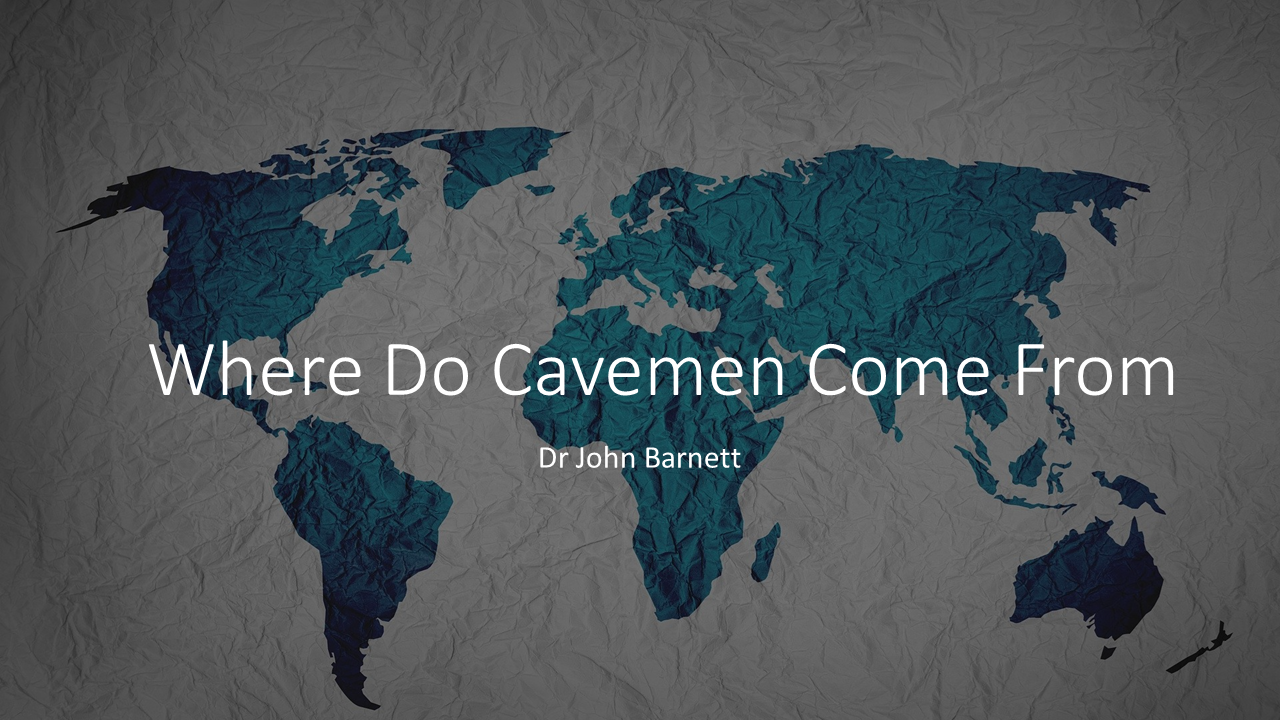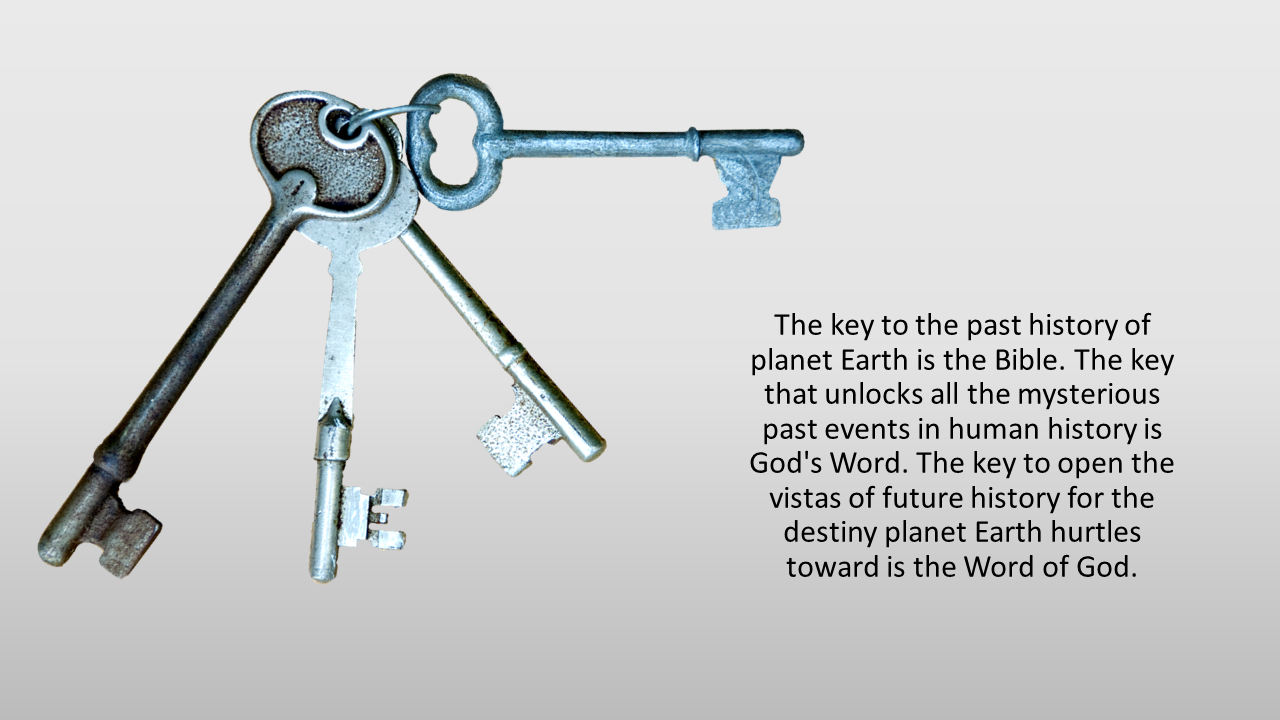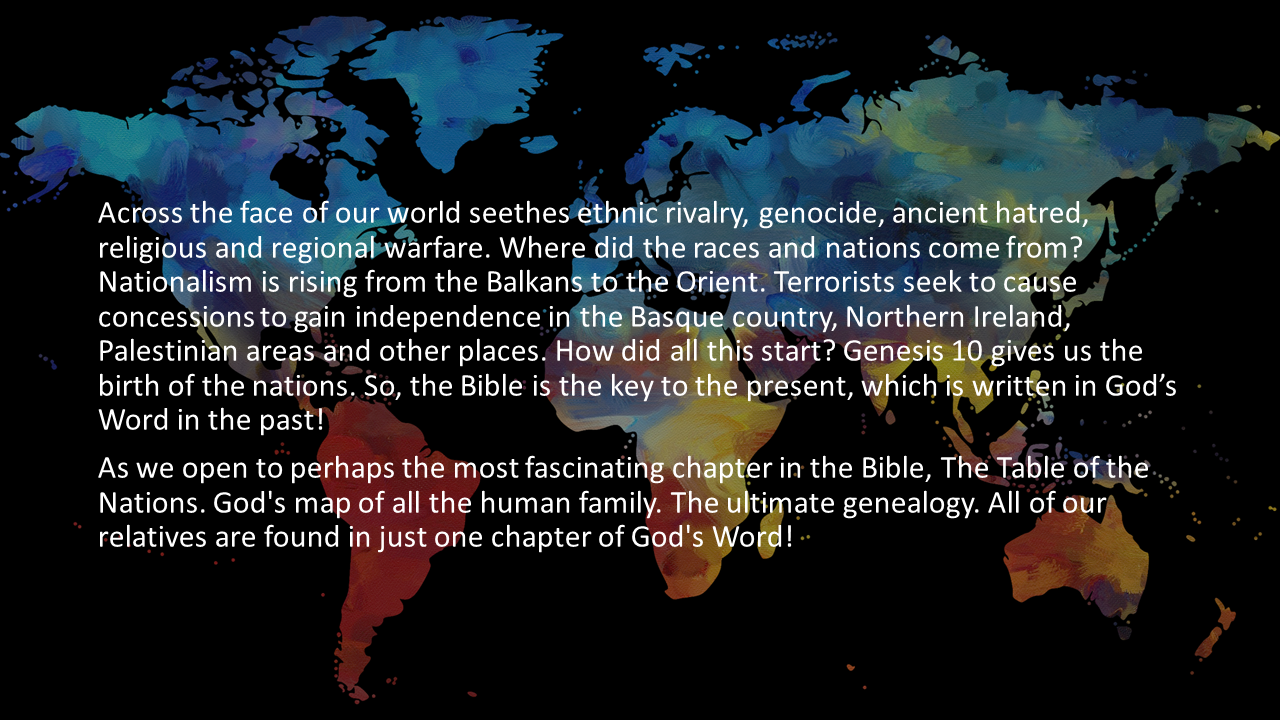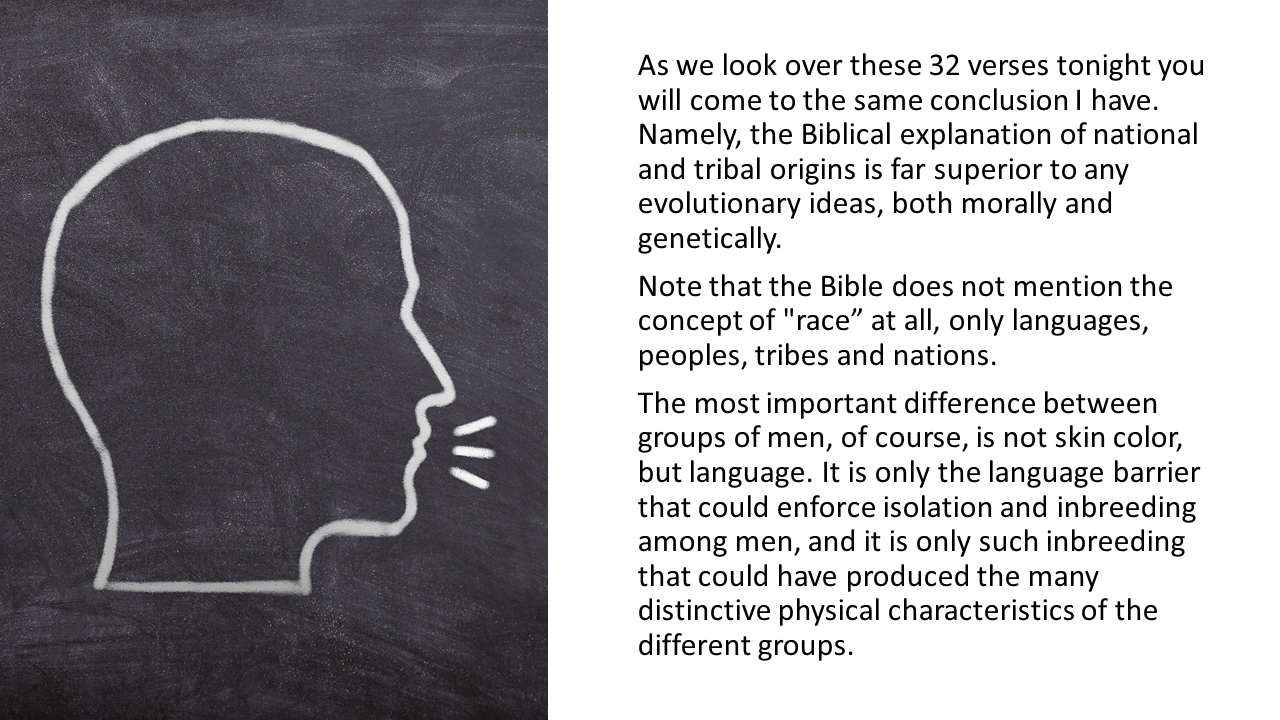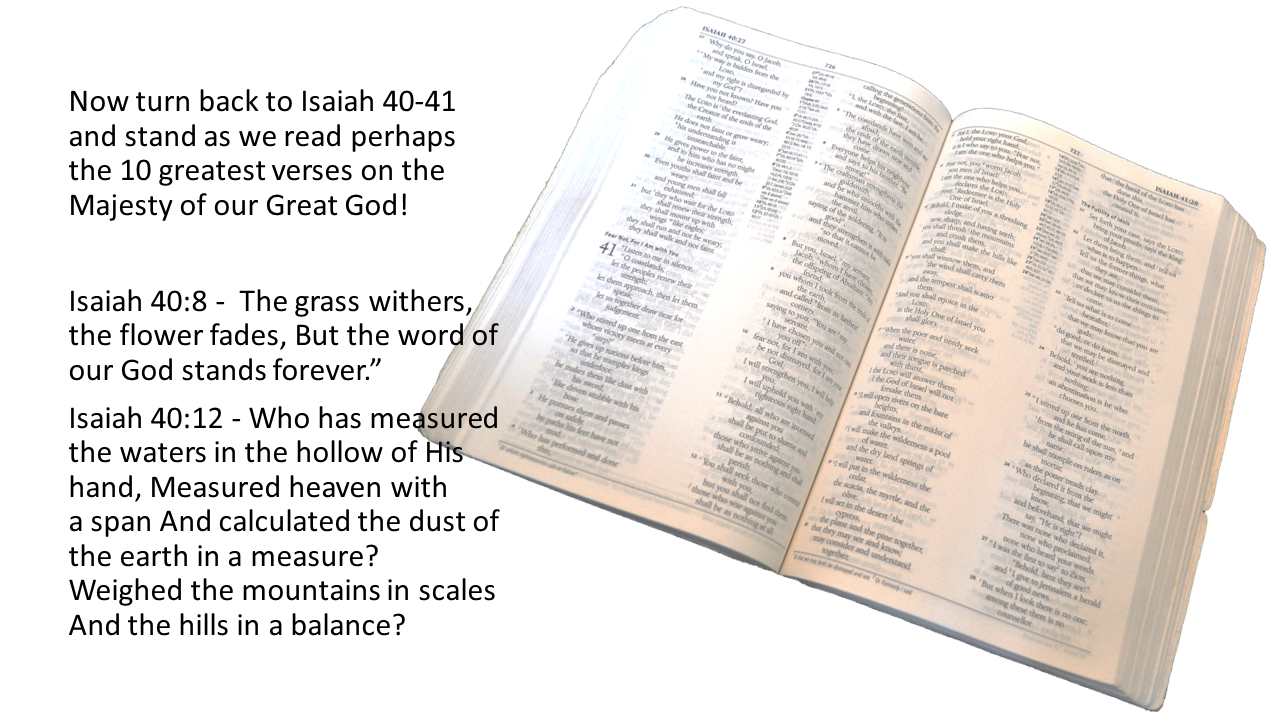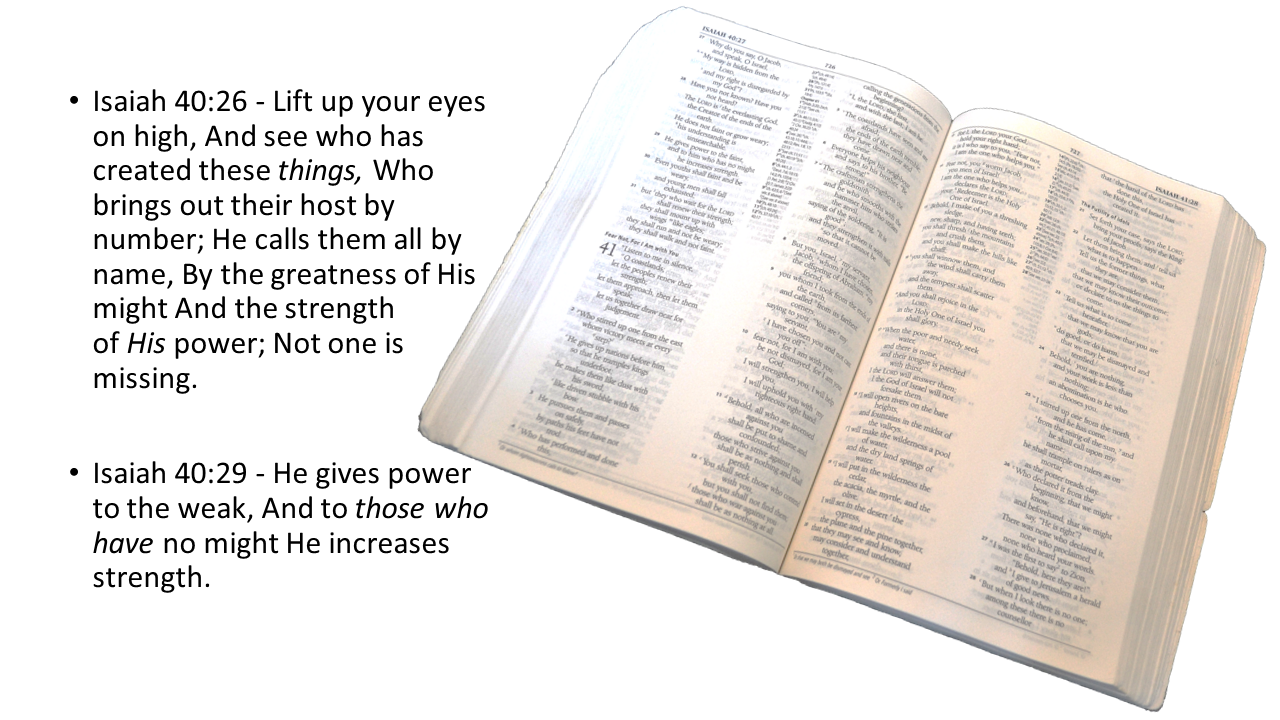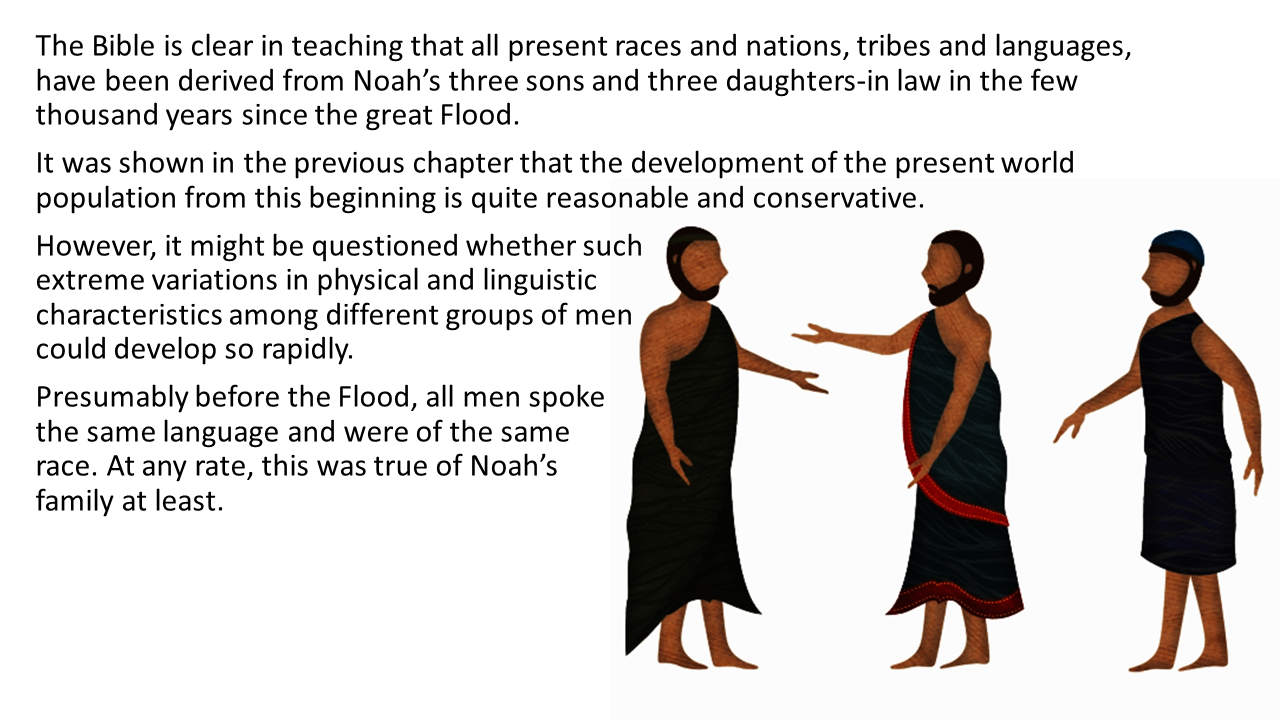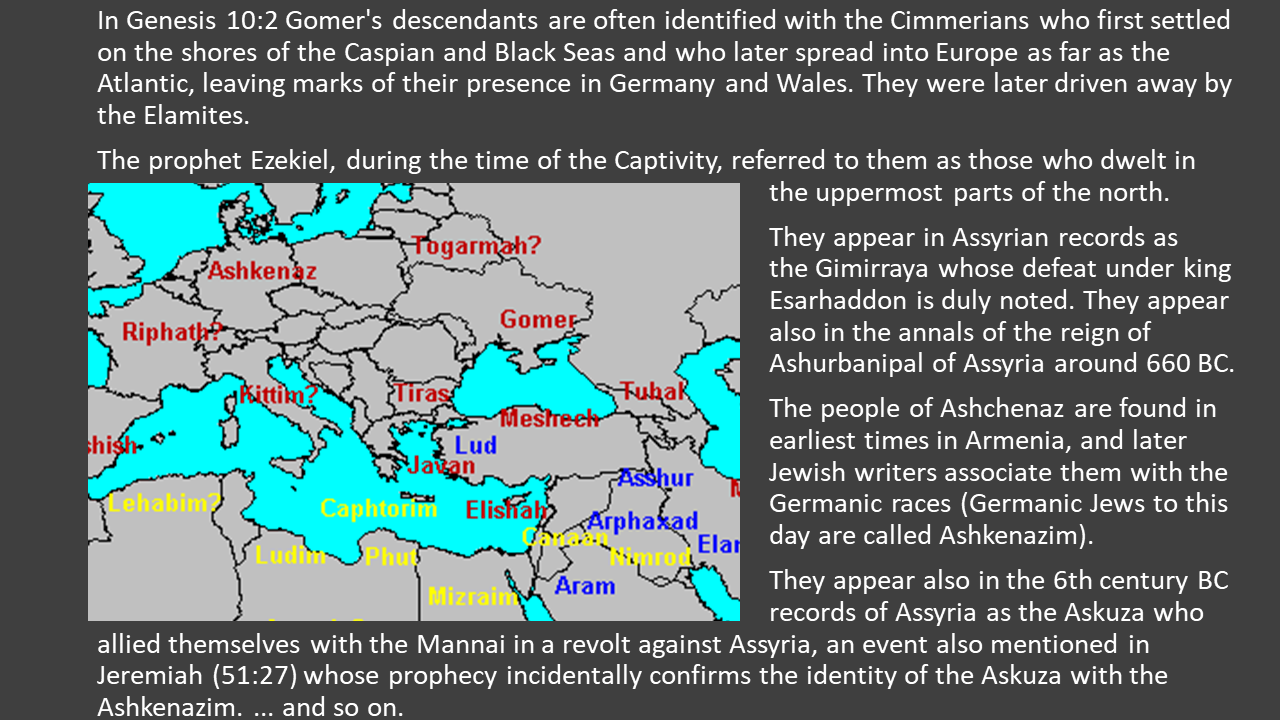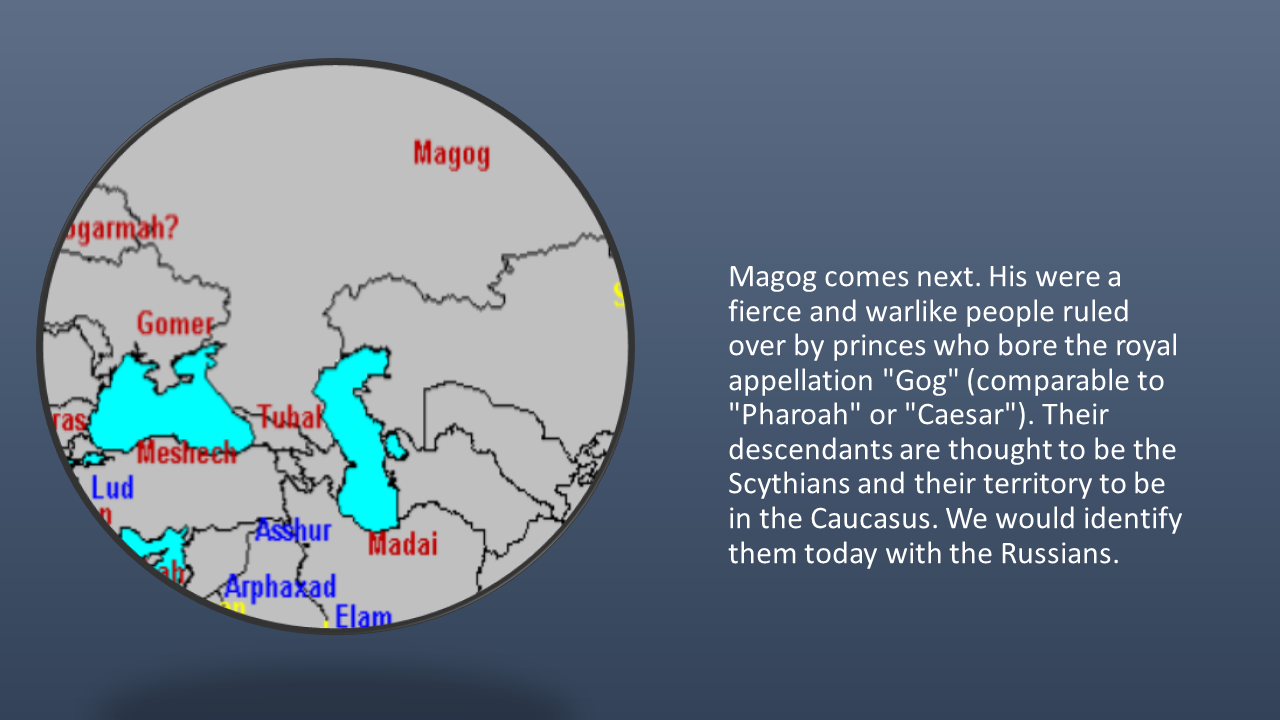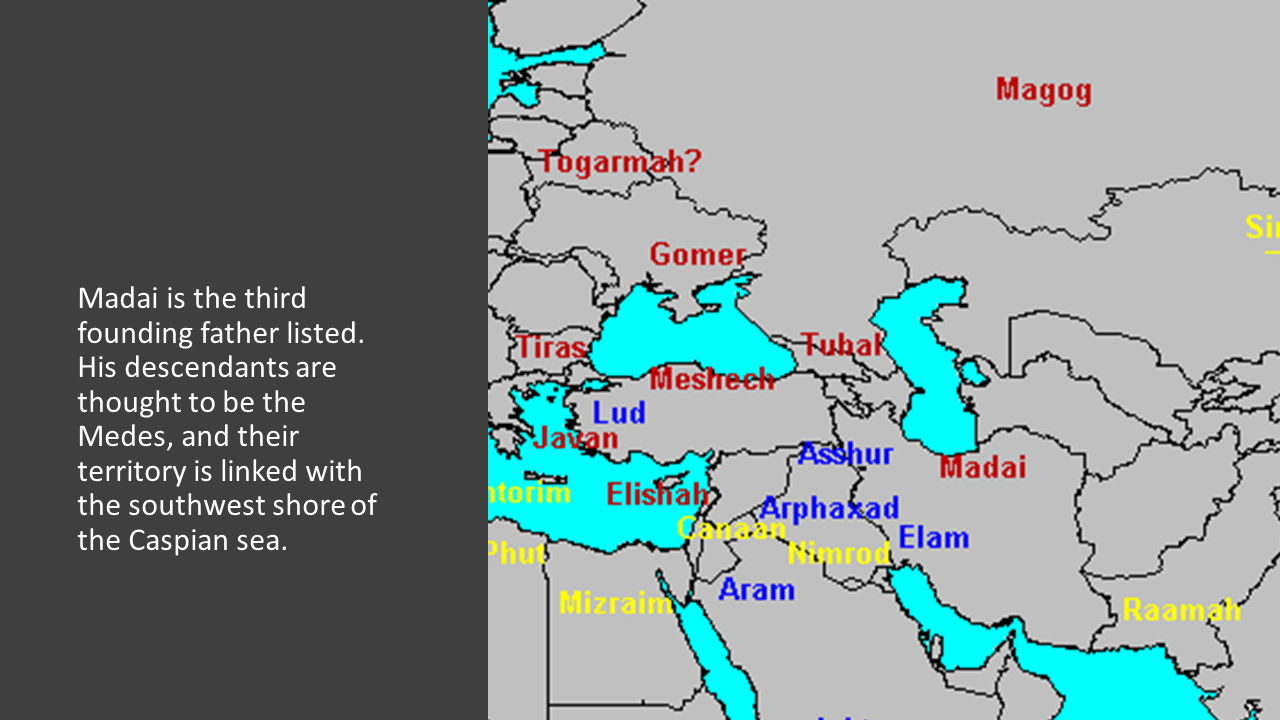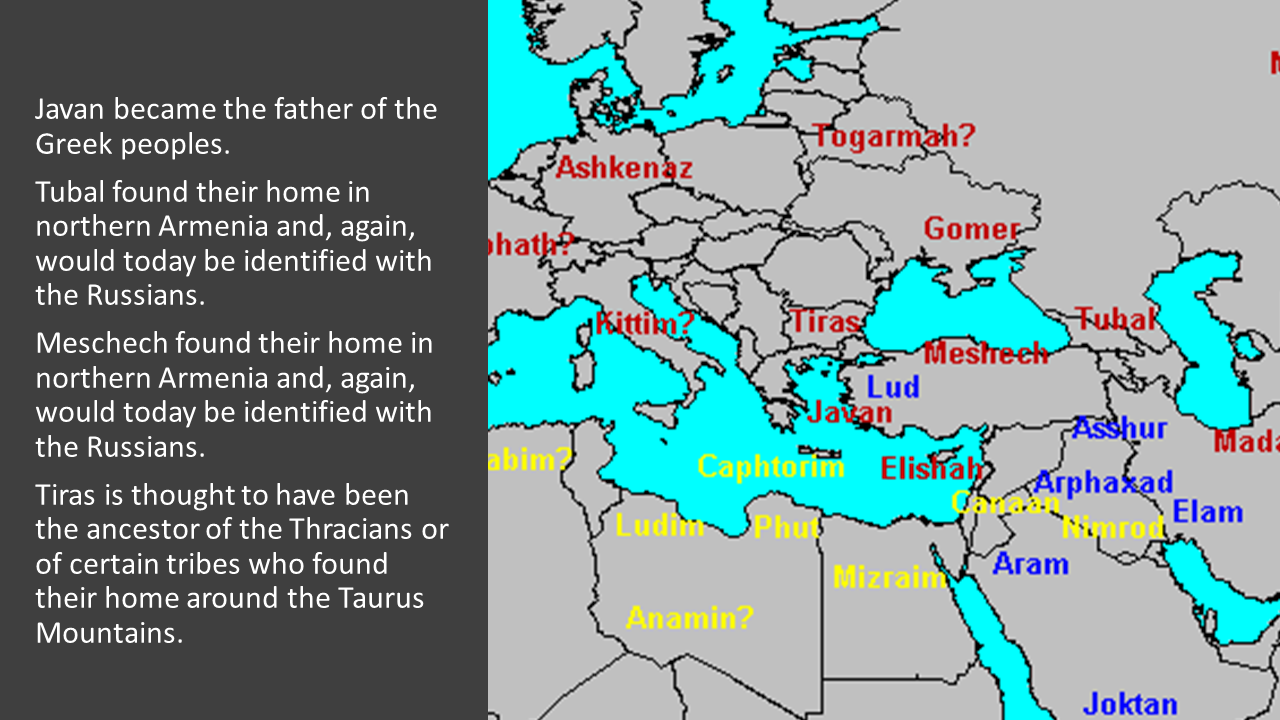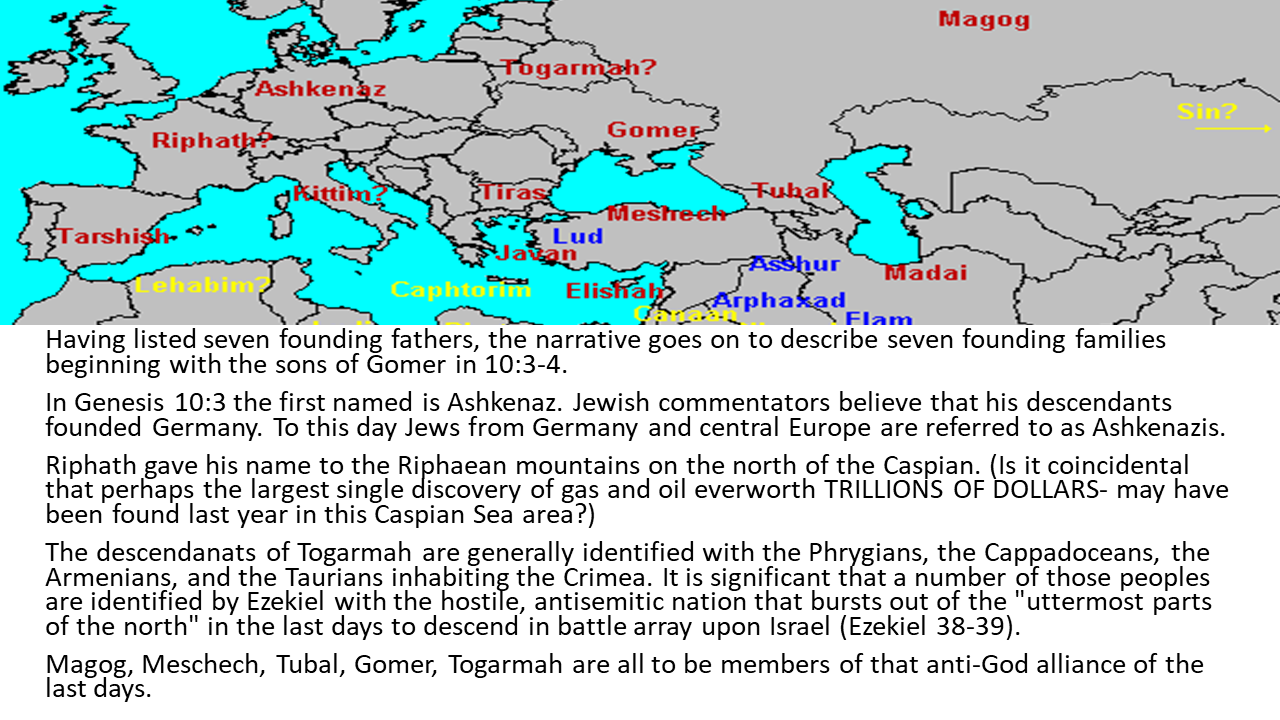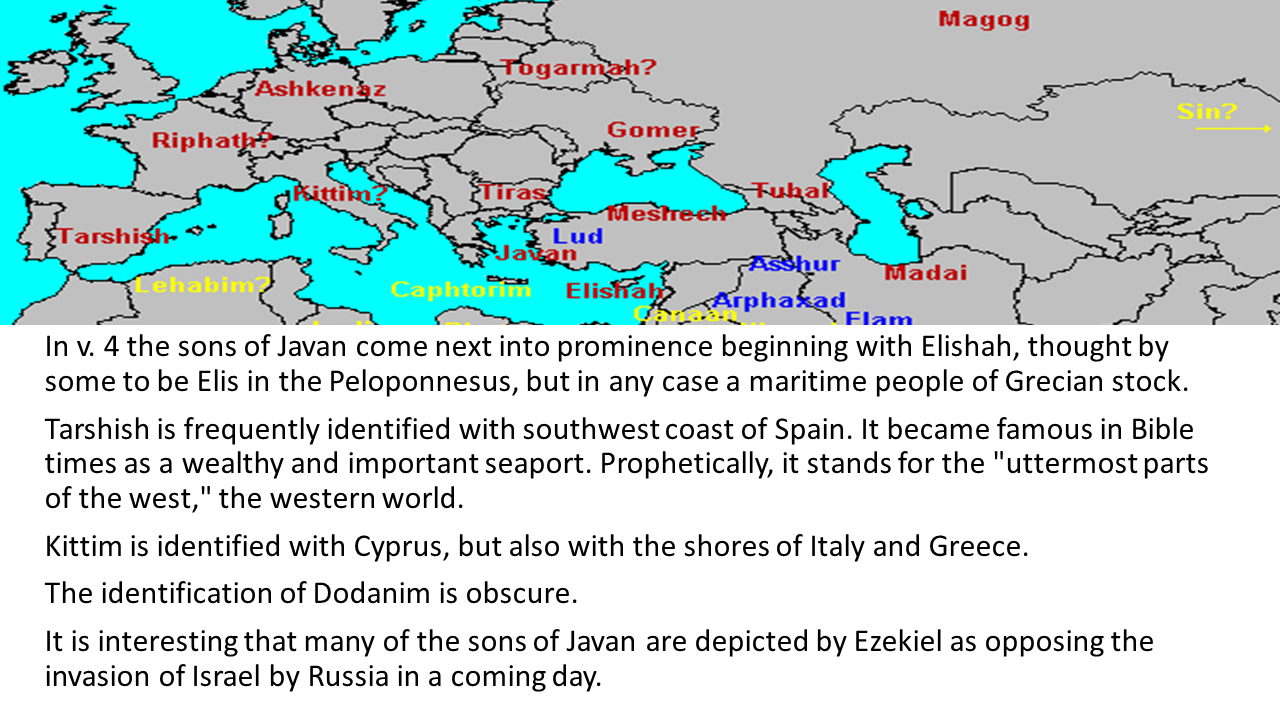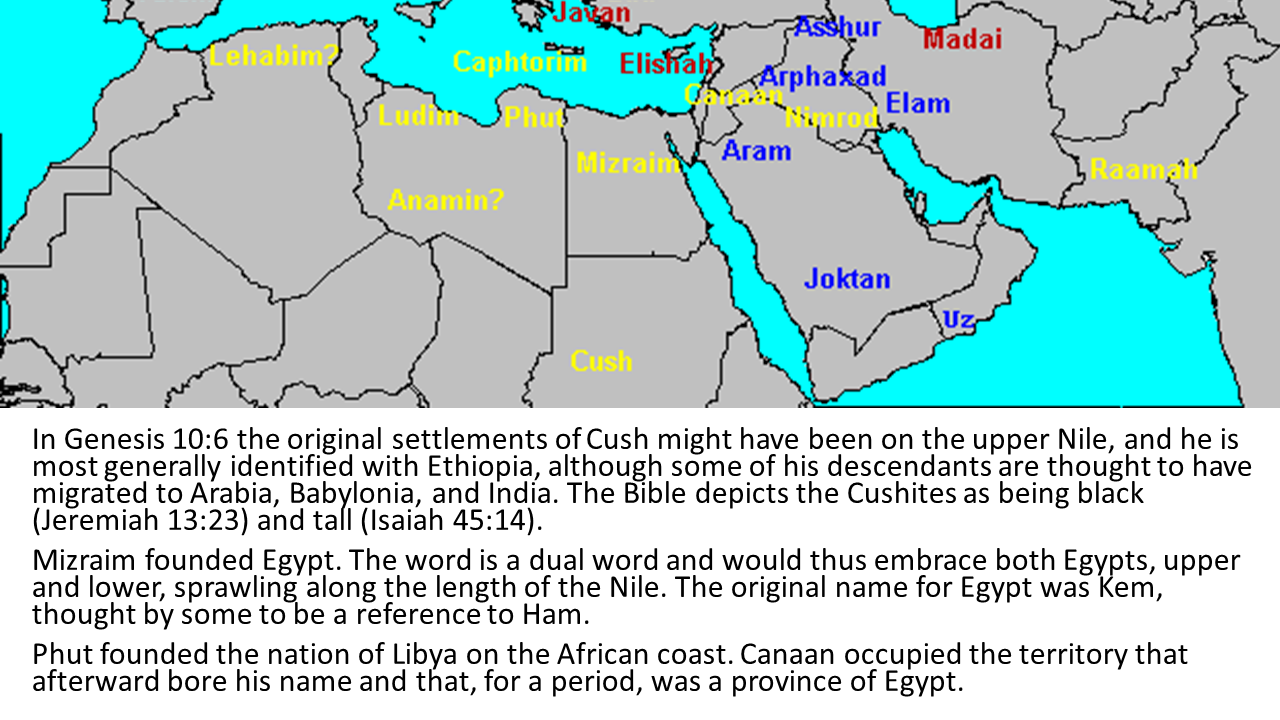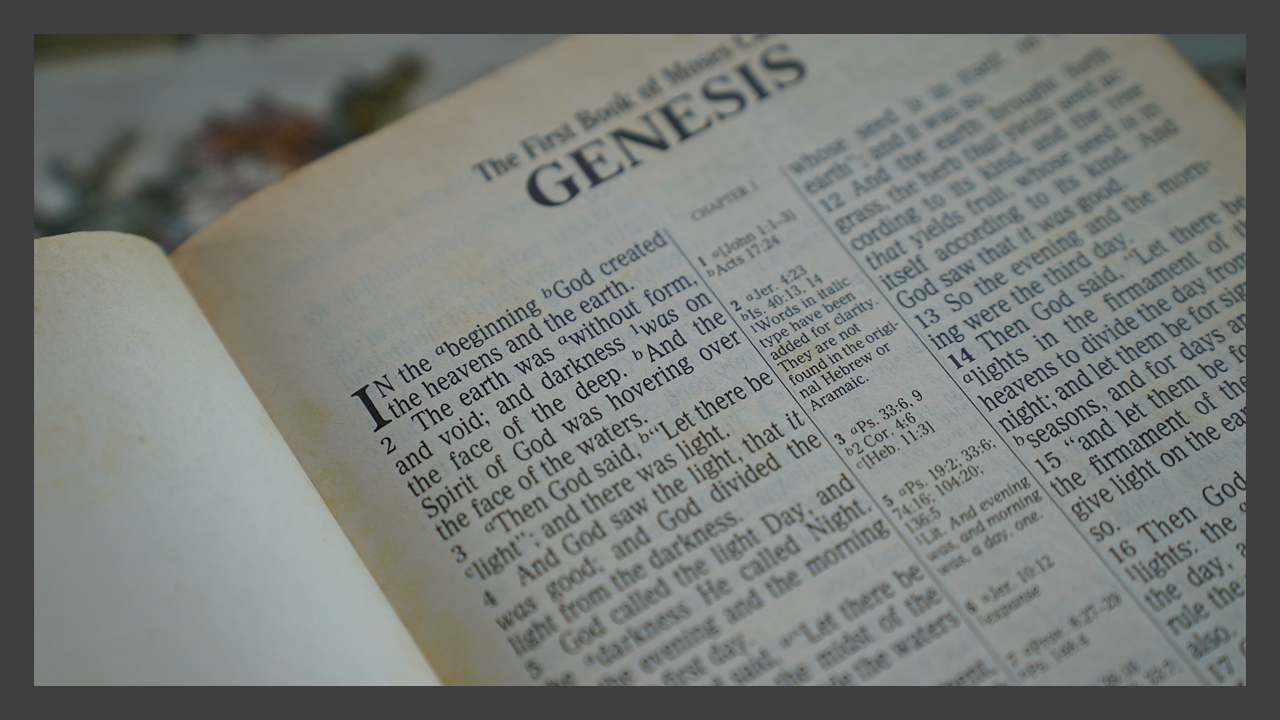Where do Cavemen come
BNW-05 GEN-29 LWP-17
001001PM
Across the face of our world seethes ethnic rivalry, genocide, ancient hatred, religious and regional warfare. Where did the races and nations come from? Nationalism is rising from the Balkans to the Orient. Terrorists seek to cause concessions to gain independence in the Basque country, Northern Ireland, Palestinian areas and other places. How did all this start? Genesis 10 gives us the birth of the nations. So, the Bible is the key to the present, which is written in God’s Word in the past!
 Open with me to perhaps the most fascinating chapter in the Bible, The Table of the Nations. God’s map of all the human family. The ultimate genealogy. All of our relatives are found in just one chapter of God’s Word!
Open with me to perhaps the most fascinating chapter in the Bible, The Table of the Nations. God’s map of all the human family. The ultimate genealogy. All of our relatives are found in just one chapter of God’s Word!
As we look over these 32 verses tonight you will come to the same conclusion I have. Namely, the Biblical explanation[1] of national and tribal origins is far superior to any evolutionary ideas, both morally and genetically. Note that the Bible does not mention the concept of “race” at all, only languages, peoples, tribes and nations. The most important difference between groups of men, of course, is not skin color, but language. It is only the language barrier that could enforce isolation and inbreeding among men, and it is only such inbreeding that could have produced the many distinctive physical characteristics of the different groups.
Now turn back to Isaiah 40-41 and stand as we read perhaps the 10 greatest verses on the Majesty of our Great God! They are 40:8, 12, 15, 18, 22, 26, 29, 31; 41:4, 10. Why study Genesis 10? To know how truly great Thou our God Art!
God created Adam and Eve the first couple of humans in the History of Earth, they had 2 sons, 2 lines, God chose one Abel’s. Only one of Abel’s line survived the Flood. So God again chose one couple – the Noah’s to start over with, they had 3 sons. God worked down one line Shem’s to one man – Abraham, through a son of promise Isaac, to a son of election Jacob, to 12 sons of which one was Judah through whom came Jesus the Christ! WOW! God is in charge and directs the affairs of humans who as they make absolutely responsible choices, do His will.
Now to Genesis 10. As far as the early nations are concerned, the three major groups of nations naturally stemmed from the three sons of Noah. Seventy original nations are listed in Genesis 10, extending evidently to sometime soon after the scattering of the people from Babel.
In general, the Table shows the descendants of Japheth (10:2-5) migrating into Europe, those of Ham (10:6-20) southward into Africa, and those of Shem (10:22-32) remaining in western Asia. Although not certain, it seems probable that the Far East was later settled by certain groups from the Hamitic and Japhetic nations. In any event, there is certainly nothing in either Genesis 10 or Genesis 11 that has been disproved by archaeology.

Origin of Races and Nations[2] The Bible is clear in teaching that all present races and nations, tribes and languages, have been derived from Noah’s three sons and three daughters-in-law in the few thousand years since the great Flood. It was shown in the previous chapter that the development of the present world population from this beginning is quite reasonable and conservative. However, it might be questioned whether such extreme variations in physical and linguistic characteristics among different groups of men could develop so rapidly. Presumably before the Flood, all men spoke the same language and were of the same race. At any rate, this was true of Noah’s family at least.
Several[3] major European royal genealogies can be traced all the way back to Noah’s sons, and the Table of Nations listed in: Genesis, chapters 10-11. This is another important evidence points us directly back to our true ancient history; one which is on the order of thousands of years and in concurrence with the Bible’s true record of our ancient history. Bill Cooper, of Middlesex, England, wrote and edited “After the Flood” in 1995 after spending over 30 years carefully researching ancient European genealogies. “After the Flood” is a compiled summary of this extensive research; all of which is independently verifiable from within the archives of several national libraries.
Listen to Dr. Cooper, “When applied to the Table of Nations, this healthy historical research yields some surprising facts, surprising that is, in the light of what most commentaries go to such great lengths to assure us of, namely that Genesis is not to be trusted as accurate history. The Table of Nations is a simple genealogy, I wanted to see how many of its names were attested in the records of other nations in the Middle East, which included for my purposes all the nations of Mesopotamia, Arabia, Egypt, Turkey and even Greece. Over the years[4], little by little, pieces of corroborative evidence came together and a picture began to build up that revealed the tenth and eleventh chapters of Genesis to be an astonishingly accurate record of events. The Table of Nations had listed all the families and tribes of mankind in their correct groupings, whether those groupings were ethnological, linguistic or geographical. All the names, without exception, were accurate, and in more than twenty-five years of searching and analyzing, I uncovered not one mistake or false statement of fact in the Table of Nations. “
The Japhetic Races[5] (10:1-5)
In His governmental dealings with mankind, God saw to it that the races were dispersed over the globe. The confounding of human speech at Babel was intended to force the nations apart and hasten their distribution over the face of the planet. The table of nations begins with the Japhetic races. In all, fourteen Japhetic families are listed in v. 2-5, thirty Hamitic families are listed in v. 6-20 and twenty-six Semitic families in v. 21-32, making a total of seventy families altogether.
A summary of the nations of the Middle East concerning the descendants of Japheth, show the trend of that evidence in vindicating the Genesis account. Moreover, the Japhetic line is the briefest in the Table of Nations.
The Japhetic list in the Table of Nations looks like this when set out as a conventional genealogy:
Very briefly then, as we consider just a few of the names in the Japhetic[6]list, we find that in the mythology of the old world, Japheth was regarded as the father of many peoples, particularly the Indo-European nations. The pagan Greeks perpetuated his name as Iapetos, the son of heaven and earth and again the father of many nations. We find his name in the Vedas of India where it appears in Sanskrit as Pra-Japati, Father Japheth, who was deemed to be the sun and lord of creation, the source of life in other words for those descended from him. Later, the Romans were to perpetuate his name as that of Ju-Pater, Father Jove, later standardized to Jupiter. We shall see also that the early Irish Celts, the early Britons and other pagan European races traced the descent of their royal houses from Japheth, including the Saxons who knew him as Sceaf (pr. sheaf or shaif). And all these peoples, we must remember, were pagans whose knowledge or even awareness of the book of Genesis was non-existent.
Thus it comes about that, throughout the entire Table of Nations, whether we talk about the descendants of Shem, Ham or Japheth, every one of their names is found in the records of the early surrounding nations of the Middle East, even the many obscure names of certain remote Arab tribes that are otherwise not evident in any modern history book of the times, and enough is available for a detailed history to be written about them. It is a phenomenon of immense implications.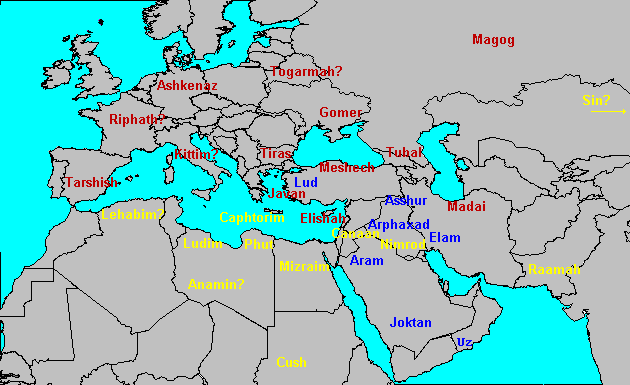
First the founders of the Japhetic nations are listed, beginning with Gomer.
- In Genesis 10:2 Gomer’s descendants are often identified with the Cimmerians who first settled on the shores of the Caspian and Black Seas and who later spread into Europe as far as the Atlantic, leaving marks of their presence in Germany and Wales. they were later driven away by the Elamites. The prophet Ezekiel, during the time of the Captivity, referred to them as those who dwelt in the uppermost parts of the north. They appear in Assyrian records as the Gimirraya whose defeat under king Esarhaddon is duly noted. They appear also in the annals of the reign of Ashurbanipal of Assyria around 660 BC. The people of Ashchenaz are found in earliest times in Armenia, and later Jewish writers associate them with the Germanic races (Germanic Jews to this day are called Ashkenazim). They appear also in the 6th century BC records of Assyria as the Askuza who allied themselves with the Mannai in a revolt against Assyria, an event also mentioned in Jeremiah (51:27) whose prophecy incidentally confirms the identity of the Askuza with the Ashkenazim. … and so on.
- Magog comes next. His were a fierce and warlike people ruled over by princes who bore the royal appellation “Gog” (comparable to “Pharoah” or “Caesar”). Their descendants are thought to be the Scythians and their territory to be in the Caucasus. We would identify them today with the Russians.
- Madai is the third founding father listed. His descendants are thought to be the Medes, and their territory is linked with the southwest shore of the Caspian sea.
- Javan became the father of the Greek peoples.
- Tubal found their home in northern Armenia and, again, would today be identified with the Russians.
- Meschech found their home in northern Armenia and, again, would today be identified with the Russians.
- Tiras is thought to have been the ancestor of the Thracians or of certain tribes who found their home around the Taurus.
Having listed seven founding fathers, the narrative goes on to describe seven founding families beginning with the sons of Gomer in 10:3-4.
- In Genesis 10:3 the first named is Ashkenaz. Jewish commentators believe that his descendants founded Germany. To this day Jews from Germany and central Europe are referred to as Ashkenazis. Riphathgave his name to the Riphaean mountains on the north of the Caspian. (Is it coincidental that perhaps the largest single discovery of gas and oil ever- worth TRILLIONS OF DOLLARS- may have been found last year in this Caspian Sea area?) The descendants of Togarmah are generally identified with the Phrygians, the Cappadoceans, the Armenians, and the Taurians inhabiting the Crimea. It is significant that a number of those peoples are identified by Ezekiel with the hostile, antisemitic nation that bursts out of the “uttermost parts of the north” in the last days to descend in battle array upon Israel (Ezekiel 38-39). Magog, Meschech, Tubal, Gomer, Togarmah are all to be members of that anti-God alliance of the last days.
- In v. 4 the sons of Javan come next into prominence beginning with Elishah, thought by some to be Elis in the Peloponnesus, but in any case a maritime people of Grecian stock. Tarshish is frequently identified with southwest coast of Spain. It became famous in Bible times as a wealthy and important seaport. Prophetically, it stands for the “uttermost parts of the west,” the western world. Kittim is identified with Cyprus, but also with the shores of Italy and Greece. The identification of Dodanim is obscure. It is interesting that many of the sons of Javan are depicted by Ezekiel as opposing the invasion of Israel by Russia in a coming day.
The statement concerning the Japhetic nations closes with a summary (10:5) of the geographical, philological, tribal, and national divisions of the “Gentiles” (goyim). Those are the nations that came to power after the fall of Babylon and that have controlled the world ever since. Positive identification of some of the peoples and territories cannot be made. Scholars differ on the matter.
The Hamitic Races[7] (10: 6-20)
The table next turns to the Hamitic races. In the early dawn of human history they were the vigorous, aggressive peoples, the early empire builders, the controllers of human destiny. It must have seemed to the old world skeptics that God’s prophetic word through Noah regarding the enlargement of Japheth was singularly at fault. Not so. God’s prophecies are frequently long-range and take time to mature. With those ancient skeptics it was their perspective that was at fault, not prophecy.
The Hamitic list begins with notable names (10:6-7), the first of which is Cush.
- In Genesis 10:6 the original settlements of Cush might have been on the upper Nile, and he is most generally identified with Ethiopia, although some of his descendants are thought to have migrated to Arabia, Babylonia, and India. The Bible depicts the Cushites as being black (Jeremiah 13:23) and tall (Isaiah 45:14).
- Mizraim founded Egypt. The word is a dual word and would thus embrace both Egypts, upper and lower, sprawling along the length of the Nile. The original name for Egypt was Kem, thought by some to be a reference to Ham.
- Phut founded the nation of Libya on the African coast. Canaanoccupied the territory that afterward bore his name and that, for a period, was a province of Egypt.
- In genesis 10:7 a number of the sons of Cush are listed, most of whom settled the country between the Arabian Sea and the Persian Gulf or else Ethiopia. Seba‘s descendants seem to have occupied Nubia in northern Ethiopia.
- The sons of Havilah are identified with what was essentially Semitic territory between the Arabian Sea and Persian Gulf. That vast territory was large enough to accommodate peoples from both major races. The sons of Sabtah are linked both with Ethiopia and Arabia. Both Raamah‘s and Sabtechah‘s descendants are linked with the Persian Gulf. Two of Raamah’s sons are listed. Sheba‘s name has been linked with the great city of that name in Arabia and Dedan‘s name is associated with the Persian Gulf.
In Genesis 10:8-12 Nimrod whom we covered in our RCC and Revelation study became a kingdom builder and the founder perhaps of idolatry, astrology, and all the black arts.
Next Moses begins to point toward the origins of God’s Nation of Israel[8].First Mizraim‘s descendants are listed. They are all peoples associated with Egypt. The writer gives the added note in v. 14 that the Philistines originally sprang from Egyptian stock. The word “Philistim” is said to be derived from an Ethiopic root meaning “to emigrate.”
The descendants of Canaan are listed last.
- In Genesis 10:15 the first and foremost of those was Sidon (10:15) who founded the oldest Canaanite city which, together with its sister city, Tyre, became a famous commercial and maritime center. Phoenician explorers and colonists set forth from those cities. Carthage, the ancient rival of Rome on the African coast, was a colony of Tyre.
- In Genesis 10:16-20 Heth founded the Hittite nation. The Jebusitesheld Jerusalem until David’s mighty men wrested it from them. The Amorites entrenched themselves on both sides of the Jordan and in the mountains that afterward belonged to Judah. Little or nothing is known of the Girgashites. The Hivites were villagers or “settlers in cities.” The Arkites and the Sinites, the Arvadites and the Zemaritestogether with the Hamathites complete the list of Canaanite tribes. Those were the peoples whose culture and religion were so vile that God later commanded their complete extermination.
The Semetic Races[9] (10:21-32)
Having dealt with the other peoples, Moses concentrates on the Semitic races. Very little is known about Shem, where he lived, what he did, the size of his family, the convictions that he had. Abraham was a distant descendant of Shem 7 GREATS! (his great-great-great-great-great-great-great-grandson if the chronologies are complete), and Abraham lived an utter pagan in thriving Ur of the Chaldees.
One supposition is that Shem and Melchizadek were one and the same persons, though there is little proof to substantiate that. But, if it were so, if the famous Melchizadek of Salem were indeed the long-lived Shem, then Abraham must have doubly felt his loss. The list is carried down to Peleg and Joktan, in whose day the great sundering of mankind took place, doubtless a reference to the confusion of tongues at Babel.
In Genesis 10:22 the first of Shem’s sons was Elam, who settled the mountainous district east of Babylonia. Asshur comes next; he founded the nation of Assyria. Arphaxad‘s territory is said to be north of Assyria. The descendants of Lud were the Lydians of Asia minor, having migrated there from countries more closely identified with Shem. The descendants of Aramsettled in Damascus and Mesopotamia.
In v. 23 we see four of Aram‘s descendants are named. The land of Uz was settled by his firstborn. Uz was a tract of territory southeast of Palestine in the Arabian desert, famous as the place where Job lived. His other sons, Hul, Gether, and Mash, are thought to have settled in Armenia.
In v. 24 Shem’s third son, Arphaxad, is the most important in the entire list of nations because it was through him the royal line led to Abram and thence to Christ. Nothing is known of Salah, Shem’s grandson, except that his name means “extensioin,” implying, perhaps, that he was an early colonist. His importance lies in the fact that his son was Eber, the father of the Hebrew people. The name “Eber” means “emigrants.” His descendants came from “the other side of the flood” (that is, the Euphrates) to Canaan (Joshua 24:2-3, 14-15).
In v. 25 Eber‘s two sons both rank high in the list. Peleg‘s name means “division,” appropriately enough. The division of mankind into nations and the curse of tongues at Babel are commemorated in his name. At that point Moses leaves the royal line for a while and ends the table of nations with a brief summary of the related line that ran through Joktan[10].
In v. 26-31 Joktan is thought to be the father of the Arabians. His thirteen sons are listed. Almodad is thought to have founded Yemen, Ophir is probably Oman on the Persian Gulf. The other sons are all more or less linked with Arabia.
In v. 32 while concluding the table of nations, Moses gives a brief summary. “these are the families of the sons of Noah, after their generations, in their nations: and by these were the nations divided (the word means ‘disrupted,’ emphasizing man’s disruption in judgment) in the earth after the flood: (10:32). The whole chapter emphasizes the completeness of man’s dispersal and the picture it gives, although some of its details may be uncertain today, is certainly one of worldwide dispersal.
Idolatry and the occult runs clearly through all the cultures of the great past empires. Each had an underlying belief in astrology. This was the cohesive force which bound together all the witchcraft, sorcery, and magic. Kings would seldom make a move without consulting advisors steeped in the ancient art of Babylonian religion. The ancient priests enjoyed royal stature and power, especially in Egypt.
So even before the first[11] major historic kingdom, Assyria, with its occult-mad capital city of Ninevah (see Nahum 3:4) – mankind was already idolatrous. This idolatry only increases with the second major kingdom Egypt, which devoted much of its total wealth to the construction of pyramids, all built according to astrological specifications. Egypt was also given to black magic (see Exodus 7:11, 22; 8:7, 18; 2 Tim. 3:9). The third was the neo-Babylonian empire of Daniel’s day, which really perfected the black arts. The fourth was Medo-Persia, which conquered Babylon but was in turn enslaved by the Babylonian religion. The fifth was the Greek empire. One visit to Greece and her ancient temple sites will convince you of the sway which idolatrous religions held there!
This is the reason why every nation and tribe of the past or present (except those whose cosmogony is based on 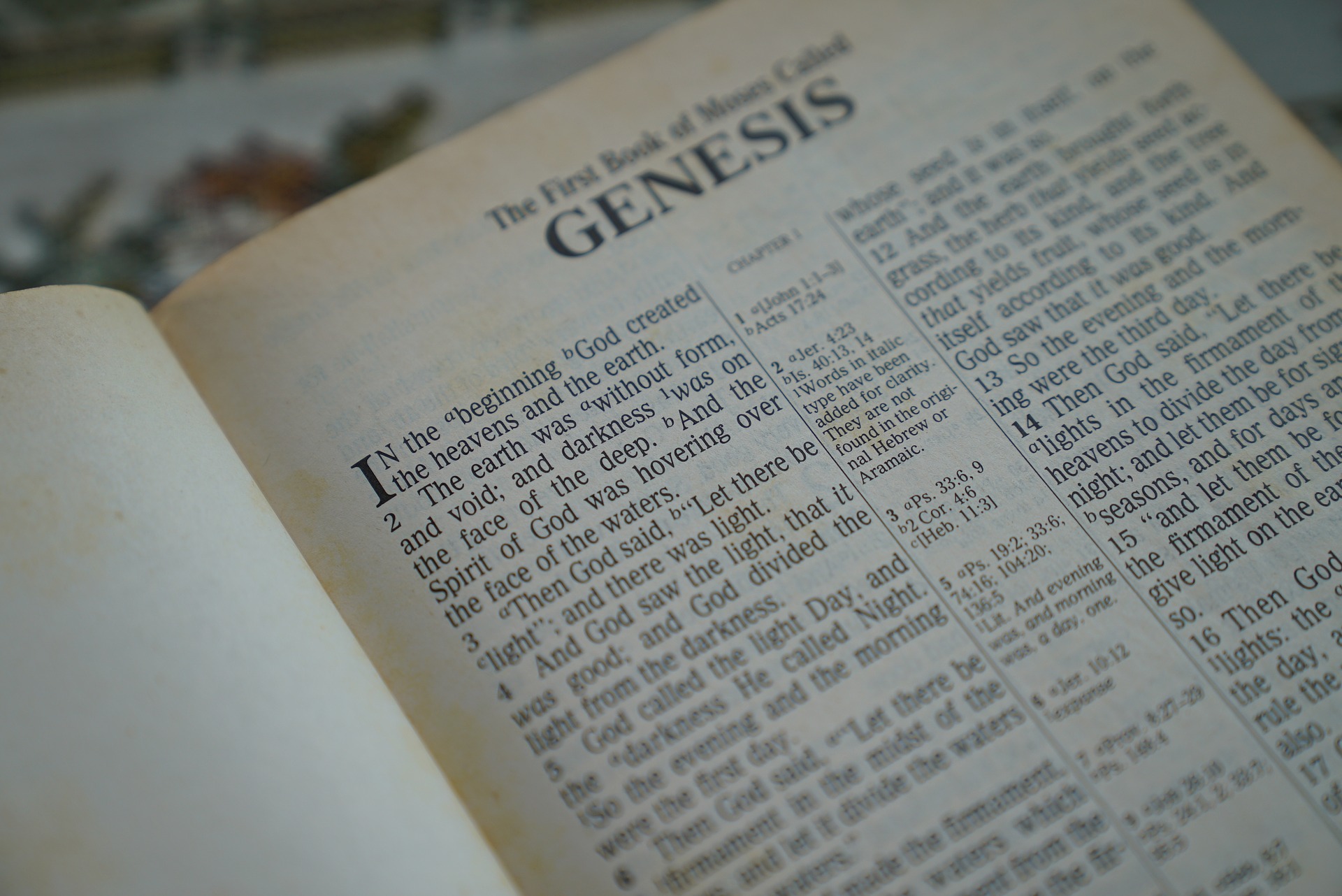 Genesis 1 and 2, such as Christianity, Judaism, and Islam) has a religious system which is fundamentally:
Genesis 1 and 2, such as Christianity, Judaism, and Islam) has a religious system which is fundamentally:
pantheistic (believing that the physical universe rather than the transcendent Creator of that universe, is the ultimate reality),
polytheistic (believing that this deified cosmos manifests itself locally as various forces and systems of nature, which are personified as “gods” and “goddesses”),
idolatrous (believing that these gods and goddesses, or personified forces and systems of nature, should be worshiped through images constructed to represent them and which they then possess and energize). This monstrous system of evolutionary, polytheistic, pantheistic, spiritistic, astrological idolatry has permeated practically every culture in the world in one form or another. Even modern evolutionary scientism is nothing but this same ancient paganism in more sophisticated garb. All religions and philosophies except those founded on special creation as revealed in Genesis worship and serve the creation more than the Creator (Romans 1:25) and thus are under God’s condemnation. They are either
ü evolutionary (believing that these personified forces of nature somehow generate higher and higher orders of beings, including man and–in many cases–even spirits),
ü animalistic/spiritistic (believing that the spirits so generated, including the spirits of dead men and women, continue to survive and perhaps evolve into still higher beings),
ü astrological (believing that the highest beings so developed either inhabit or are identical with the starry host of heaven, so that these stars control events on earth), and
ü humanistic (worshiping man as the highest attainment of the cosmic process)
Idolatry is Foolishness Isaiah 44
Those who make an image, all of them are useless,
And their precious things shall not profit;
They are their own witnesses;
They neither see nor know, that they may be ashamed.
Who would form a god or mold an image
That profits him nothing?
Surely all his companions would be ashamed;
And the workmen, they are mere men.
Let them all be gathered together,
Let them stand up;
Yet they shall fear,
They shall be ashamed together.
The blacksmith with the tongs works one in the coals,
Fashions it with hammers,
And works it with the strength of his arms.
Even so, he is hungry, and his strength fails;
He drinks no water and is faint.
The craftsman stretches out his rule,
He marks one out with chalk;
He fashions it with a plane,
He marks it out with the compass,
And makes it like the figure of a man,
According to the beauty of a man, that it may remain in the house.
He cuts down cedars for himself,
And takes the cypress and the oak;
He secures it for himself among the trees of the forest.
He plants a pine, and the rain nourishes it.
Then it shall be for a man to burn,
For he will take some of it and warm himself;
Yes, he kindles it and bakes bread;
Indeed he makes a god and worships it;
He makes it a carved image, and falls down to it.
He burns half of it in the fire;
With this half he eats meat;
He roasts a roast, and is satisfied.
He even warms himself and says,
“Ah! I am warm,
I have seen the fire.”
And the rest of it he makes into a god,
His carved image.
He falls down before it and worships it,
Prays to it and says,
“Deliver me, for you are my god!”[12]
Idols and the True God
Hear the word which the Lord speaks to you, O house of Israel.
2 Thus says the Lord:
“Do not learn the way of the Gentiles;
Do not be dismayed at the signs of heaven,
For the Gentiles are dismayed at them.
For the customs of the peoples are futile;
For one cuts a tree from the forest,
The work of the hands of the workman, with the ax.
They decorate it with silver and gold;
They fasten it with nails and hammers
So that it will not topple.
They are upright, like a palm tree,
And they cannot speak;
They must be carried,
Because they cannot go by themselves.
Do not be afraid of them,
For they cannot do evil,
Nor can they do any good.”
Inasmuch as there is none like You, O Lord
(You are great, and Your name is great in might),
Who would not fear You, O King of the nations?
For this is Your rightful due.
For among all the wise men of the nations,
And in all their kingdoms,
There is none like You.
But they are altogether dull-hearted and foolish;
A wooden idol is a worthless doctrine.
Silver is beaten into plates;
It is brought from Tarshish,
And gold from Uphaz,
The work of the craftsman
And of the hands of the metalsmith;
Blue and purple are their clothing;
They are all the work of skillful men.
But the Lord is the true God;
He is the living God and the everlasting King.
At His wrath the earth will tremble,
And the nations will not be able to endure His indignation.
Thus you shall say to them: “The gods that have not made the heavens and the earth shall perish from the earth and from under these heavens.”
He has made the earth by His power,
He has established the world by His wisdom,
And has stretched out the heavens at His discretion.
When He utters His voice,
There is a multitude of waters in the heavens:
“And He causes the vapors to ascend from the ends of the earth.
He makes lightning for the rain,
He brings the wind out of His treasuries.”
Everyone is dull-hearted, without knowledge;
Every metalsmith is put to shame by an image;
For his molded image is falsehood,
And there is no breath in them.
They are futile, a work of errors;
In the time of their punishment they shall perish.
The Portion of Jacob is not like them,
For He is the Maker of all things,
And Israel is the tribe of His inheritance;
The Lord of hosts is His name
The reason why Neanderthal Man was somewhat stooped and brutish in structure was not because he was newly evolved from the ape, but because he had health problems.
“Now, at long last, thanks to the investigations of Dr. Francis Ivanhoe of London, who published his findings in the August 8, 1970, issue of Nature, the Neanderthal puzzle may have been solved. His review of the currently available anthropological and medical evidence shows that Neanderthal Man was evidently the victim of his decision to move too far north at the wrong time, the onset of a glacial age. In doing so, contends Dr. Ivanhoe, he lost sufficient contact with the ultra-violet rays of the sun and because his diet did not provide the missing nutrient, he contracted rickets, the Vitamin D deficiency disease, which was to deform him for thousands of years to follow.”20-9[13]
 BINGO! Now enters God’s Word! This picture of Neanderthal Man fits well with the concept of early post-Flood man struggling to cope with a difficult environment. As the Book of Job (38:30 “waters harden like stone, the surface of the deep is frozen” NKJV) may allude to, the glacial period followed soon after the Flood. As we learned in World that Perished in the Genesis Flood , all this was brought on by the changed climatic conditions occasioned by the Flood. Before God destroyed the Old World, there had probably been a global mild, sub-tropical climate everywhere. The most probable explanation for such a universal mild climate was a worldwide “greenhouse effect.” Such an effect could be produced only by a worldwide canopy of some sort, the most likely nature of which would be a vast thermal blanket of invisible water vapor above the troposphere. Such a canopy is suggested by the “waters above the firmament” of Genesis 1:7, the complete absence of rain suggested in Genesis 2:5, and the establishment of the rainbow only following its dissipation as one cause of the Flood (Genesis 7:11; 9:13).
BINGO! Now enters God’s Word! This picture of Neanderthal Man fits well with the concept of early post-Flood man struggling to cope with a difficult environment. As the Book of Job (38:30 “waters harden like stone, the surface of the deep is frozen” NKJV) may allude to, the glacial period followed soon after the Flood. As we learned in World that Perished in the Genesis Flood , all this was brought on by the changed climatic conditions occasioned by the Flood. Before God destroyed the Old World, there had probably been a global mild, sub-tropical climate everywhere. The most probable explanation for such a universal mild climate was a worldwide “greenhouse effect.” Such an effect could be produced only by a worldwide canopy of some sort, the most likely nature of which would be a vast thermal blanket of invisible water vapor above the troposphere. Such a canopy is suggested by the “waters above the firmament” of Genesis 1:7, the complete absence of rain suggested in Genesis 2:5, and the establishment of the rainbow only following its dissipation as one cause of the Flood (Genesis 7:11; 9:13).
When the canopy was precipitated at the Flood, the present global extremes of temperature became established, snow began to fall and the great continental ice caps gradually developed. The resulting glacial epoch probably persisted for many centuries in the northern latitudes, at the same time there were pluvial climates and great civilizations developing in the lower latitudes.
Thus Neanderthal Man may not have been quite the equal in ability or intelligence of those tribes who were living farther south, but he was certainly a true man, no more different from other groups of modern men than various tribes of modern men today are from each other.
“He had a brain with a capacity sometimes larger than that of modern man. He was a talented toolmaker and successful hunter, even dabbled in art and, most importantly from a cultural standpoint, developed a rudimentary social and religious consciousness.”20-10[14]
There seems little of substance remaining in the old evolutionary ideas that man is merely an evolved animal. Both physiologically and behaviorally, man has always been man and the ape has always been an ape. Except for the exaggerated chronologies still employed by the evolutionists, all that we really know of man’s early history fits in perfectly well with the Biblical implications of the nature and migrations of men after the Flood.
- [1] Portions quoted from Morris, Trilogy, electronic version, n.p.
- [2] Henry Morris, Creation Trilogy, electronic edition, n.p.
- [3] Bill Cooper, After the Flood, electronic edition, chaper 2, n.p.
- [4] Bill Cooper, After the Flood, electronic edition, chaper 2, n.p.
- [5] John Phillips, Exploring Genesis, Moody Press, Chicago, 1980, pp. 96-98.
- [6] Bill Cooper, After the Flood, electronic edition, chaper 2, n.p.
- [7] John Phillips, Exploring Genesis, Moody Press, Chicago, 1980, pp. 99.
- [8] John Phillips, Exploring Genesis, Moody Press, Chicago, 1980, pp. 99.
- [9] John Phillips, Exploring Genesis, Moody Press, Chicago, 1980, pp. 99.
- [10] John Phillips, Exploring Genesis, Moody Press, Chicago, 1980, pp. 99.
- [11] Hal Lindsey
- [12]The New King James Version, (Nashville, TN: Thomas Nelson Publishers) 1998, c1982.
- [13] 20-9. “Neanderthal Man, Victim of Malnutrition,” Prevention (October, 1971), p. 116.
- [14] 20-10. “Neanderthal Man, Victim of Malnutrition,” Prevention (October, 1971), p. 117.
Slides
Check Out All The Sermons In The Series
You can find all the sermons and short clips from this series, Brave New World – Devils here.
You can find all the sermons and short clips from this series, Genesis here.
You can find all the sermons and short clips from this series, Lost World – The World that Perished here.
Looking To Study The Bible Like Dr. Barnett?
Dr. Barnett has curated an Amazon page with a large collection of resources he uses in his study of God’s Word. You can check it out here.

